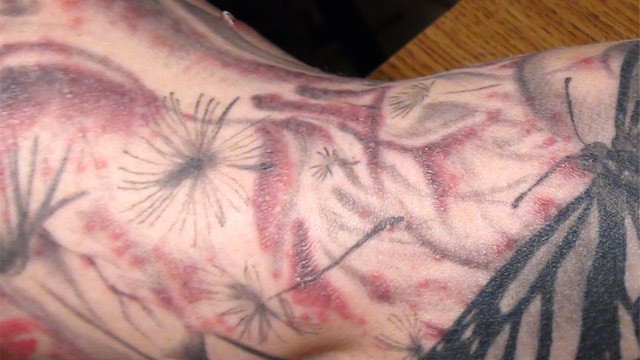Police believe drive-by shootings at an Ogden home Tuesday night and Wednesday morning may be related to a violent power struggle within a street gang over control of leadership, drugs and money. Ogden Police Lt. Scott Conley declined to identify the gang, but said members are not affiliated with the Ogden Trece. On Monday, 2nd District Judge Ernie Jones issued a permanent injunction against Trece members, banning them from associating with each other in public and being in the presence of guns, drugs and alcohol. The injunction also places Treces under an 11 p.m. curfew. The drive-by shootings at a home in the 500 block of 28th Street are signs of in-fighting among members of a local gang who are attempting to resolve their differences through escalating violence, Conley said. “They are in the same gang and are arguing back and forth,” he said, noting police have gathered intelligence on the dispute. “We are taking enforcement action to eradicate the problem or get the individuals involved incarcerated.” Six to eight gang members are believed to be involved in the dispute.
Translate
Monday, 27 August 2012
Saturday, 25 August 2012
The nine people believed injured by stray police gunfire outside the Empire State Building were not the first to learn how dangerous a crowded street can be in a gunfight.
Civilians occasionally find themselves in harm's way when officers use deadly force, though usually only a handful of times annually. When that happens, a rigid process of investigation is set in motion — and the police department can reasonably expect a lawsuit. The latest episode came when police say a man disgruntled over losing his job a year ago shot a former colleague to death and pointed his weapon at two police officers in the shadow of a major tourist attraction. He apparently wasn't able to fire before police killed him, one firing off seven rounds and the other nine. Bystanders suffered graze wounds, and some were struck by concrete gouged from buildings by the bullets, authorities said. At least one person said he was actually hit by a bullet. Robert Asika, a 23-year-old tour guide who was hit in the right arm, said he was "100 percent positive" he was shot by a police officer. A witness told police that laid-off clothing designer Jeffrey Johnson fired at officers, but ballistics evidence so far contradicts that, authorities said.
Thursday, 23 August 2012
Tracking a Rare Tattoo-Related Infection
A Trail of Ink: Tracking a Rare Tattoo-Related Infection

This trail began when the man received a tattoo in Rochester, N.Y. in October 2011. A short while later, he noticed the raised, bumpy rash. He called his primary care physician.
Doctors initially treated the man's arm with topical steroids, thinking that the rash was allergic-contact dermatitis. But that only made the problem worse.
By the time dermatologist Dr. Mark Goldgeier saw the patient, it was clear that this was no simple allergy.
He performed a skin biopsy so he could take a closer look at the rash under a microscope. What he saw was startling: the sample was riddled with a wormlike bacterium related to tuberculosis.
"I explained [to the patient] that he had TB, and he had a look of horror on his face," Goldgeier said.
For the patient, the finding meant a trip to an infectious disease specialist to start up to a full year of treatment.
Goldgeier, meanwhile, called the Monroe County Health Department.
"As soon as biopsy came back," he said, "I knew something in the process of tattooing was involved -- the ink, the water used for dilution, the syringes, the dressings."
And so began a nationwide medical mystery.
Dr. Byron Kennedy, public health specialist at Monroe County Department of Public Health, took over the case from Goldgeier. Kennedy first confirmed the results by repeating a skin biopsy on the patient. Once again, tendrils of mycobacterium chelonae, a type of tuberculosis-related skin bacteria, showed up in the sample.
Mycobacterium chelonae is a rapidly growing bug found in soil, dust, water, animals, hospitals, and contaminated pharmaceuticals. This family of bacteria does not commonly affect healthy individuals, but in patients with suppressed immune systems -- like those with HIV or on chemotherapy -- these bacteria can cause serious disease, often resulting in death.
The finding sent Kennedy and his associates to the tattoo parlor where the patient had been inked. Everything in the clinic was sterile, which made it unlikely that the infection had arisen there. But the tattoo artist, they learned, had been using a new gray premixed ink purchased in Arizona in April 2011; he used the ink between May and December 2011.
The ingredients of the ink -- pigment, witch hazel, glycerin, and distilled water -- seemed innocuous enough. But further examination revealed that the distilled water in the pigment was the likely culprit of the contamination.
The finding raised a number of questions -- not the least of which was how the bottles of premixed ink passed U.S. Food and Drug Administration regulations.
The U.S. Centers for Disease Control and Prevention acknowledged this gap in regulations Wednesday in its Morbidity and Mortality Weekly report.
"Under the Federal Food, Drug, and Cosmetic Act, tattoo inks are considered to be cosmetics, and the pigments used in the inks are color additives requiring premarket approval," the report says.
Armed gang fight breaks out in Venezuelan prison
Twenty-five people were killed and 43 others hurt in a prison battle in Venezuela as two armed gangs vied for control of a penitentiary near Caracas, authorities said on Monday.












